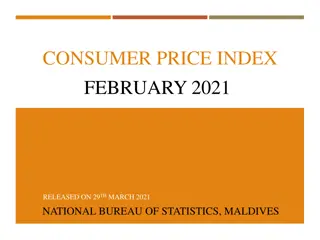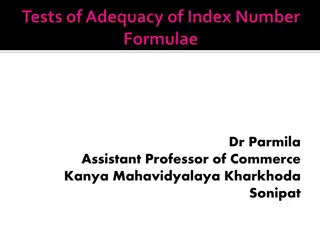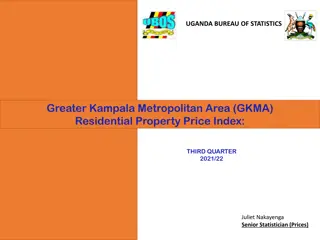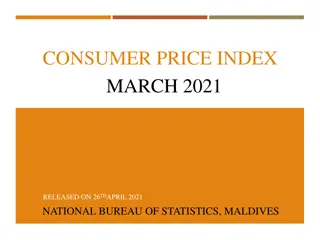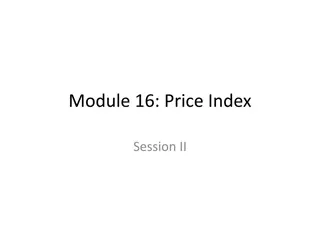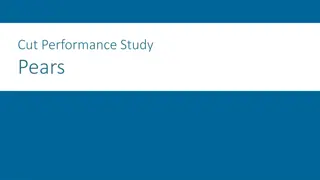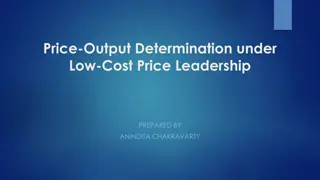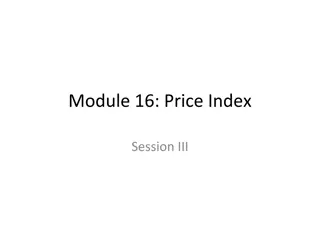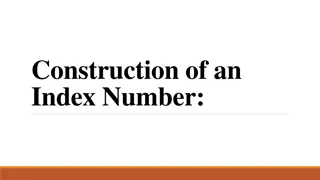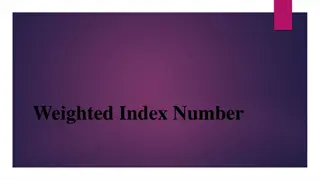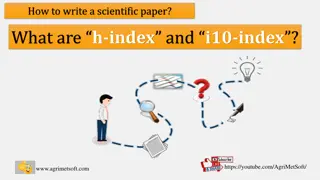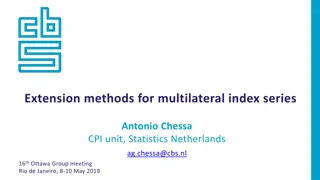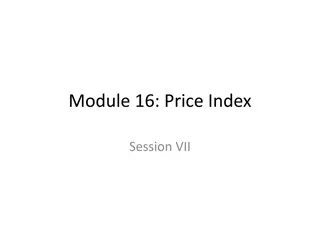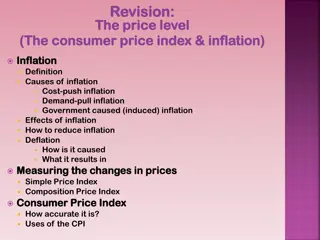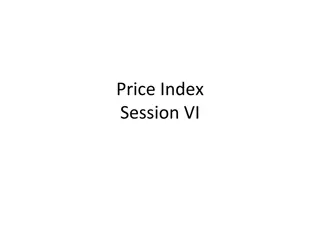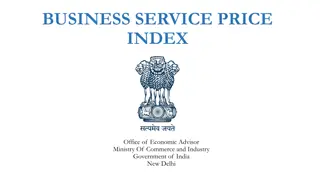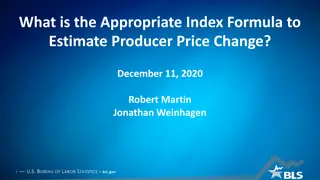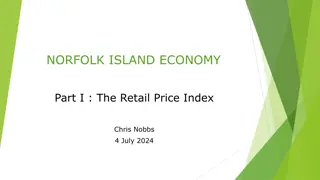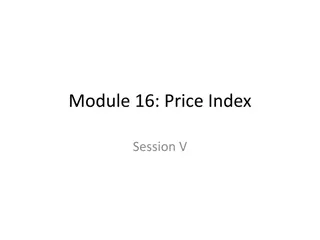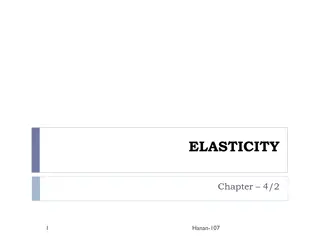Understanding Price Index: Issues and Concepts
Price indices play a crucial role in measuring changes in prices of goods and services. This presentation covers the construction of price indices, defining purposes, selecting base periods, assigning weights, and more. Explore the purpose, scope, and coverage of price indices as measures of inflation and standards of living. Learn how price changes can be decomposed into factors to understand relative price levels and structures.
Download Presentation

Please find below an Image/Link to download the presentation.
The content on the website is provided AS IS for your information and personal use only. It may not be sold, licensed, or shared on other websites without obtaining consent from the author. Download presentation by click this link. If you encounter any issues during the download, it is possible that the publisher has removed the file from their server.
E N D
Presentation Transcript
Module 16: Price Index Session IV
Contents Session IV Constructing Price Index - Part I Issues involved Price Index Purpose,Scope and Coverage Periodicity and Timeliness 3
Constructing Price Index Issues involved
Constructing Price Index Construction of Price Index Numbers Price indices are useful indicators of measuring change in prices of a group of goods and services. But its actual usefulness for analytical and predictive purposes depends on how well the choice of method and actual compilation are made. The main compilation issues involved in designing a price index is indicated in the next slide. 5
Constructing Price Index Issues Involved 1. Defining Purpose 2. Frequency periodicity and timeliness 3. Choice of Base period 4. Assigning Weights 5. Selection of items 6. Choice of data collection method 7. Choice of method of calculation. In this session, we will take up the first two issues. The rest will be discussed in the following sessions. 6
Price Index Purpose, Scope and Coverage Price Index as a Measure of Inflation Price index relating to standard of living Purpose served by a price index Scope and coverage of Price Index
Price Index Scope & Coverage Decomposition of Price Change Price relative of ith commodity between base period and the tth time point ?????0 Can be decomposed into two factors: 1. Change in the general price level and 2. Change in price structure, i.e. change in relative prices Price indices are measures of the general price level, but each of them is a partial measure. 8 8
Price Index Scope & Coverage Example 16: Decomposition of Price Change an example (with just 3 products) product p0 Relative price product pt Price relative Relative price Base period Case 1 current period A 10 1.0 A 12 1.2 1.0 B 20 2.0 B 24 1.2 2.0 C 15 1.5 C 18 1.2 1.5 p0: price in base period pt: price in base period Price relative = pt/ p0 Relative price : (price of the product) / price of A) Case 2 current period A 10 1.0 1.0 B 16 0.8 1.6 C 18 1.2 1.8 9 9
Price Index Scope & Coverage Example 16: Decomposition of Price Change (Contd.) product p0 Relative price product pt Price relative Relative price Base period Case 3 current period A 10 1.0 A 13 1.3 1.0 B 20 2.0 B 22 1.1 1.7 C 15 1.5 C 18 1.2 1.4 For uniform weights of 1/3 of all the products: Case 1: rise in general price level by 20%, with no change in price structure. Case 2: no change in general price level, but change in price structure. Case 3: rise in general price level by 20%, with change in price structure. 10 10
Price Index Scope & Coverage General Price Level In real life, we invariably find price change of the Case 3 kind. Generally, an overall increase in the price level is accompanied by a change in the structure of relative prices, but it is only the overall [average] prices increase, not the relative price change, that constitutes inflation General Price level: an economy-wide price index covering all money transactions occurring during the time period may be able to represent the general price level. Increase in average prices of all goods and services in an economy should be distinguished from a change in the relative prices of individual goods and services. 11 11
Price Index Scope & Coverage Coverage of PIs used as Measure of Inflation The transactions relevant for a measure of general price level or inflation are The domains of price indices meant for measuring inflation are thus confined only to market transactions. The non-market transactions, and own-use transactions are excluded since they do not involve money transactions. g&s M 12 12
Price Index Scope & Coverage Coverage of Price Indices a Market Transactions Approach MPI a part of it all market exchange g&s to Money Transactions Exports XPI PPI- output purchase of g&s & factor services purchase of existing assets & property purchases for final use other purchases PPI - final capital formation factor services Intermediate consumption input consumption households CPI Gen. Govt & NPISHs goods services 13 13
Price Index Scope & Coverage Implicit GDP Deflator There is no single price index to cover all monetary market transactions in an economy. The only indicator of change in general price level of almost all monetary and non-monetary transactions available in official statistics is from national accounts statistics. It is called the implicitGDP deflator and is defined as ??? ?? ??????? ?????? ??? ?? ??????? ?????? 100 ???????? ??? ???????? = 14 14
Price Index Scope & Coverage Implicit GDP Deflator - Coverage This is an index that measures the average price level of an economy s output relative to the base year. Percentage change in the GDP deflator, in a way, measures the rate of overall price increase for all goods and services produced in the economy. But, it does not cover purchase and sale of existing assets and properties. serve the purposes that are served by the specific price indexes. 15
Price Index Scope & Coverage Price Index as a Measure of Inflation Inflation or the rise in the general level of prices over time can be measured using a number of different indices. For assessing inflation faced by private households, the most suitable index is the consumer price index (CPI). For assessing inflation from the point of view of producers or importers of goods, the producer price index (PPI) can be the most suitable measure of inflation for certain purposes. As for building construction and housing, construction cost index may provide the most relevant picture of price trends in these industries. 16
Price Index Scope & Coverage Price index relating to standard of living A Cost of Living Index (COLI) is defined as the measure of change in the minimum cost of maintaining a given level of welfare (also known as well-being, utility, standard of living). A COLI designed to capture the change in minimum cost in response to environmental factors is called unconditional COLI), strictly speaking, is not a price index. A COLI (conditional COLI) is based on the change in the minimum cost of maintaining a given level of welfare resulting from only the changes in consumer prices, holding the environmental factors constant. 17
Price Index Scope & Coverage COLI and Inflation An unconditional COLI), strictly speaking, is not a price index. A conditional COLI qualifies as a price index A COLI reflects results of changing prices and changing expenditure patterns. Inflation in its broadest sense is concerned only with changing prices. A COLI is a more appropriate tool for negotiating income changes. An inflation index is preferred for macro-economic policy analysis. 18
Constructing Price Index Purpose Definition of Purpose The first and the foremost problem in the construction of index numbers relates to specify the purpose for which they are required. - There is no all-purpose index number as every index number has its own particular uses and limitations. - For example, a cost of living index will have different set of commodities, price quotations and weights compared with the general wholesale price index. - Again the cost of living index for workers in an industrial town will have different requirements compared with one for agricultural workers. 19
Price Index Scope & Coverage Consumer Price Index Scope CPI is a price index that measures changes in the prices of consumption goods and services acquired, or used, by households. Consumption goods & services: Are those that members of households use, directly or indirectly, to satisfy their own personal needs and wants. However, a CPI may not cover all households or all the goods and services they actually consume. For example, it may exclude: publicly provided free goods and services self consumption of goods & services out of own production consumption of banking and insurance services 20
Price Index Scope & Coverage CPI Coverage The coverage of a CPI is specified by the reference population in terms of Geographical coverage: for example rural & urban areas. Types of households: Rural labour, industrial, two or more members households etc. Socio-economic groups: native population, non-rich population, etc. 21
Price Index Scope & Coverage Producer Price Index Scope & Coverage (1) PPIs provide measures of average movements of prices received (or paid) by the producers of commodities. The scope of PPIs varies they generally reflect the changes in prices received (or paid) by a definable industry such as manufacturing, agriculture or mining. 22
Price Index Scope & Coverage Producer Price Index Scope & Coverage (2) PPIs compiled and disseminated have different scopes, such as : input price indices for the market purchase prices of raw materials/inputs to the manufacturing process; output price indices for goods as they leave the factory gate; wholesale price indices which refer to prices received by wholesalers. 23
Price Index Scope & Coverage Input and Output Producer Price Index Input producer price indices reflect changes in prices paid by producers for raw materials and intermediate goods. They are valued at purchasers prices. Output producer price indices reflect changes in ex-factory gate prices valued at basic prices, i.e., actual transaction prices of domestic production, taking account of discounts and rebates, excluding taxes and subsidies on products and excluding trade and transport margins. This is sometimes referred to as the first stage of commercialisation. 24
Price Index Periodicity and timeliness Reference period and reference time point Timeliness
Constructing Price Index Frequency Periodicity Primarily, periodicity and timeliness of compiling a price index is determined by the purpose. There are other factors as well, such as whether intended to relate to time point or a period the pattern of price movements practicalities of carrying out price collections. 26
Constructing Price Index Frequency Frequency and Purpose A price index used for monitoring inflation should be compiled with a high frequency say a week or a month. A price index for other purposes, such as index linking salaries and social benefits contract escalation and compilation of national accounts at constant prices. are required with a longer periodicity of say a month or a quarter or even annual. 27
Constructing Price Index Frequency Reference period and reference time point Price indexes are designed to refer to a time point or a period of time. A price index is said to have a reference time point, if it is based on prices collected on a particular day of the week or the month. An index is said to have a period reference, when average prices during the reference period are considered for calculation of the price index. An index number series is smoother for periodreference than reference time point. 28
Constructing Price Index Frequency Reference time point A high-frequency index is usually compiled for a reference time point or a short reference time period. High-frequency indexes are compiled for those with a limited scope. An index number series with reference time point is likely to be highly volatile in short-term. In a rapid inflation situation, monitoring authorities require price index with shorter reference period. For example, price index for crude oil or transport fuel, for which the prices could be very volatile. 29
Constructing Price Index Frequency Reference period The price indexes with broader scope usually have a longer reference time period. If intended to be used for deflating income, expenditure or sales, the index should relate to the period of time. For example, most of the countries compile CPI on a monthly basis. 30
Constructing Price Index Frequency Timeliness The required timeliness of publishing a price index is closely linked to its frequency of compilation. The high frequency price indexes used for monitoring purposes demand shorter time lag. 31


